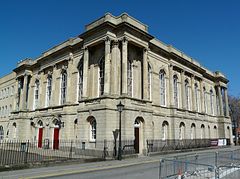Dylan Thomas Centre
| Dylan Thomas Centre | |
|---|---|
 Dylan Thomas Centre | |
 | |
| Former names | Swansea Guildhall |
| General information | |
| Architectural style | neo-classical style |
| Location | |
| Address | Somerset Place, Swansea SA1 1RR |
| Coordinates | 51°37′09.00″N 3°56′09.00″W / 51.6191667°N 3.9358333°W |
| Completed | 1829 |
| Renovated | 1995 |
| Owner | City and County of Swansea Council |
| Design and construction | |
| Architect | John Collingwood |
| Main contractor | Thomas Bowen |
| References | |
Listed Building – Grade II* | |
| Official name | The Old Guildhall (Former Annexe to Dynevor Comprehensive School) |
| Designated | 30 March 1987 |
| Reference no. | 11643 |
The Dylan Thomas Centre is an arts centre located in the Maritime Quarter in Swansea, Wales. It is a Grade II* listed building.[1]
History[]
The building was commissioned to replace a previous guildhall which had been located near Swansea Castle and dated back to the late 16th century.[2] The new building, which was designed by John Collingwood in the neo-classical style and built by Thomas Bowen, was completed in 1829.[1] It was remodelled to the plans of Thomas Taylor in 1852 using a design which was modelled on the Temple of Jupiter Stator in Rome.[1] The external design involved nine bays on each side with round-arched windows on the ground floor and tall round-arched windows flanked by Corinthian order columns on the first floor.[1]
It was converted for use as a juvenile employment centre after the civic leaders moved to the new Swansea Guildhall in 1934.[3] During the Second World War it was requisitioned by the army for use as a recruiting centre.[4] After reverting to use as a juvenile employment centre, it became a College of Further Education in 1960 and then became an annexe to Dynevor School in 1970 before closing in 1982.[4][5]
The building was officially re-opened by the American former President Jimmy Carter and the last Leader of the Swansea City Council, Trevor Burtonshaw, as the Dylan Thomas Centre in 1995.[6][7] In 2012 a large part of the Centre was leased by Swansea's council to the University of Wales with the purpose of using it as a business centre for creative industries.[8]
In October 2014, the Centre launched the permanent "Love the Words" exhibition which explores Dylan's life and work through a variety of media and including letters, books, worksheets and photographs.[9] It was made possible with support of nearly £1 million from the Heritage Lottery Fund.[10][11]
The Dylan Thomas Centre is home to a year-round programme of literary events, including book launches, plays, poetry evenings, changing exhibitions and science talks.[12] It also hosts the annual Dylan Thomas Festival held between Dylan’s birth and death dates, 27 October to 9 November.[13]
References[]
- ^ Jump up to: a b c d Cadw. "The Old Guildhall, Somerset Place (11643)". National Historic Assets of Wales. Retrieved 24 August 2020.
- ^ "The town hall by the castle". Swansea Council. Retrieved 24 August 2020.
- ^ Cadw. "Swansea Guildhall (14594)". National Historic Assets of Wales. Retrieved 15 April 2020.
- ^ Jump up to: a b "History of the Dylan Thomas Centre". Dylan Thomas Centre. Retrieved 24 August 2020.
- ^ "Dynevor School Centenary" (PDF). p. 13. Retrieved 24 August 2020.
- ^ "Dylan Thomas Centre: University of Wales leases Swansea building". BBC. 23 February 2012. Retrieved 21 July 2012.
- ^ "Jimmy Carter to welcome visitors to Dylan Thomas house". BBC. 9 November 2011. Retrieved 24 August 2020.
- ^ "Artists' fears over Dylan Thomas Centre in Swansea". 27 March 2011. Retrieved 24 August 2020.
- ^ "'Love the Words' Exhibition – Dylan Thomas.com is the official website about the writer". Retrieved 2015-09-22.
- ^ "New Exhibition Coming To Swansea's Dylan Thomas Centre". Centre Screen. Retrieved 24 August 2020.
- ^ "Dylan Thomas centre awarded nearly £1m in poet's centenary year". The Guardian. 10 April 2014. Retrieved 24 August 2020.
- ^ "Dylan Thomas Centre". Wales Tourists Online. Retrieved 24 August 2020.
- ^ "Dylan Thomas Festival". dylanthomas.com. Archived from the original on 16 July 2012. Retrieved 21 July 2012.
External links[]
 Media related to Dylan Thomas Centre at Wikimedia Commons
Media related to Dylan Thomas Centre at Wikimedia Commons- Official website

- Arts centres in Wales
- Museums in Swansea
- Grade II* listed buildings in Swansea
- Cultural infrastructure completed in 1829
- Biographical museums in Wales
- Literary museums in Wales
- 1995 establishments in Wales
- Museums established in 1995
- Dylan Thomas
- City and town halls in Wales
- Government buildings completed in 1829

